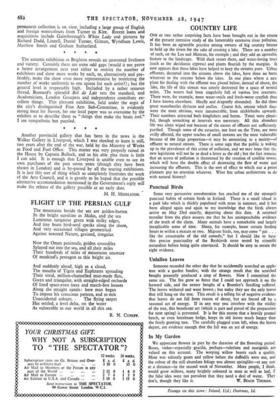COUNTRY LIFE
ONE or two rather surprising facts have been brought out in the course of the present intensive study of the lamentably extensive river pollution. It has been an agreeable practice among owners of big country houses to hold up the rivers for the sake of creating a lake. There are a number of such, on the Lea and Mimran, for example ; and they add an agreeable feature to the landscape. Wild duck resort there, and water-loving trees (such as the deciduous cypress) and plants flourish by the margins. It now appears that these lakes have helped to keep the streams pure. Urban effluents, decanted into the streams above the lakes, have done no harm whatever to the streams below the lakes. In one place where a new plant for dealing with the effluent was placed below, instead of above, the lake, the life of this stream was utterly destroyed for a space of several miles. The waters had been singularly full of various live creatures. There were, for example, more water-snails and fresh-water crayfish than I have known elsewhere. Mayfly and dragonfly abounded. So did those great waterbeetles dytiscus and asellus. Coarse fish, among which dace were the most obvious, were innumerable, from sticklebacks upwards. Their numbers attracted both kingfishers and heron. Trout were plenti- ful, though restocking at intervals was necessary. All this abundant life was clean wiped out because of the excess of effluent not sufficiently purified. Though some of the estuaries, not least on the Tyne, are most evilly affected, the upper reaches of small streams are the most vulnerable because of the large proportion—it may be amounting to a moiety—of effluent to natural stream. There is some sign that the public is waking up to the prevalence of this crime of pollution, and we may hope that the new legislation will not be so dead a letter as the old ; but the fact remains that an access of pollution is threatened by the creation of satellite towns, which will have the double effect of decreasing the flow of water and increasing the effluents. This is the sort of effect to which our a priori planners pay no attention whatever. What has urban architecture to do with natural history?




























 Previous page
Previous page